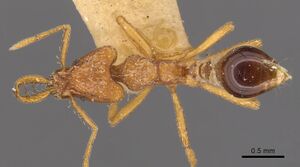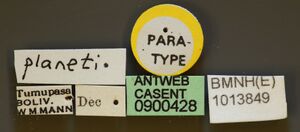Strumigenys planeti
| Strumigenys planeti | |
|---|---|

| |
| Scientific classification | |
| Kingdom: | Animalia |
| Phylum: | Arthropoda |
| Class: | Insecta |
| Order: | Hymenoptera |
| Family: | Formicidae |
| Subfamily: | Myrmicinae |
| Tribe: | Attini |
| Genus: | Strumigenys |
| Species: | S. planeti |
| Binomial name | |
| Strumigenys planeti Brown, 1953 | |
Strumigenys planeti appears to be widespread and probably rather common in the Amazon-Orinoco Basins, with an extension to Trinidad. It appears to be a rainforest species. Weber (1952) reports a nest taken in a wet mossy log in a cacao plantation on Trinidad. (Brown 1953, 1962)
Identification
Bolton (2000) - A member of the mandibularis complex in the Strumigenys mandibularis-group. The mandibles of this species are nearly as strongly bowed as in Strumigenys godmani but that species is much larger, with relatively shorter mandibles and a long and hypertrophied postpetiole disc.
Keys including this Species
Distribution
Latitudinal Distribution Pattern
Latitudinal Range: 10.35° to -14.22965°.
| North Temperate |
North Subtropical |
Tropical | South Subtropical |
South Temperate |
- Source: AntMaps
Distribution based on Regional Taxon Lists
Neotropical Region: Bolivia (type locality), Brazil, Peru, Trinidad and Tobago, Venezuela.
Distribution based on AntMaps
Distribution based on AntWeb specimens
Check data from AntWeb
Countries Occupied
| Number of countries occupied by this species based on AntWiki Regional Taxon Lists. In general, fewer countries occupied indicates a narrower range, while more countries indicates a more widespread species. |

|
Estimated Abundance
| Relative abundance based on number of AntMaps records per species (this species within the purple bar). Fewer records (to the left) indicates a less abundant/encountered species while more records (to the right) indicates more abundant/encountered species. |

|
Biology
Castes
Worker
Images from AntWeb
   
| |
| Paratype of Strumigenys planeti. Worker. Specimen code casent0900428. Photographer Will Ericson, uploaded by California Academy of Sciences. | Owned by NHMUK, London, UK. |
Nomenclature
The following information is derived from Barry Bolton's Online Catalogue of the Ants of the World.
- planeti. Strumigenys planeti Brown, 1953d: 57 (w.q.) BOLIVIA. [Strumigenys planeti Weber, 1952b: 3; unavailable name, attributed to Brown.] See also: Bolton, 2000: 536.
Unless otherwise noted the text for the remainder of this section is reported from the publication that includes the original description.
Description
Worker
TL 3.76, HL 0.89, ML 0.47, WL 0.90 mm.; CI 81, MI 53. Paratypes, 39 workers from at least 5 nest series from all of the localities listed below: TL 3.45-4.00, HL 0.80-0.89, ML 0.45-0.50, WL 0.80-0.90 mm.; CI 80-86, MI 52-57. A species intermediate between S. Strumigenys godmani and Strumigenys smithii in total size, structure and sculpture of petiole and postpetiole, proportions of head and mandibles and mandibular dentition, yet perfectly distinct from both species. The new species has in the past been confused with S. smithii, which is perhaps its closest ally, and agreement with smithii is close except in the following characters:
1. Head similar, but larger and relatively broader, with deeper and broader posterior excision and more broadly expanded occipital lobes.
2. Mandibles heavier, broader and more strongly bowed (less so than in Strumigenys mandibularis or Strumigenys godmani), and with longer, more widely spaced and more acute teeth. Apical fork of two long spiniform teeth, the ventral slightly the longest and with a weakly deflected tip; small acute intercalary tooth present. Preapical teeth at about the apical fifth and again at about the second apical fifth of the shaft, the distance between the apical fork and distal preapical tooth usually very slightly greater than that separating the distal from the proximal preapical teeth. Distal preapical tooth about the length of the dorsal tooth of the apical fork, proximal preapical tooth ¾ to 4/5 the length of the distal.
3. Fifth funicular segment very slightly shorter than I-IV taken together, or rarely about equal to I-IV. In holotype, scape L 0.58, funiculus L 0.78 rom.
4. Alitrunk as in smithii, but more robust. Propodeal lamellae each forming upper and lower subequal triangular teeth, acutely angular, but with extreme apices usually more or less blunt; portion of lamella separating the upper and lower teeth deeply excavated as a subangular or sharply rounded excision. Metanotal groove well marked.
5. Anterior slope of petiolar node distinctly and evenly convex in both directions, summit gently rounded and disappearing without interruption beneath its thick posterodorsal spongiform collar.
6. Postpetiolar disc approximately as broad as long, varying very slightly among my series in favor of length or width in different specimens; anterior border truncate, disc itself subcircular and weakly convex in both directions, its surface evenly and densely reticulo-punctate and opaque, with some short weak longitudinal rugoo ranged along its anterior border and varying in distinctness in different specimens; posterior border subtruncate.
7. Threadlike costulae at base of first gastric segment short and weak (much as in godmani), about half as numerous as those of the smithii cotypes and much more widely spaced, shorter.
8. Pilosity as in smithii cotypes, except that the shorter reclinate and subreclinate hairs of head and scapes are perhaps a trifle longer and more conspicuous.
Color yellowish- to medium ferrugineous; gaster reddish-brown to deep piceous or near-black; appendages somewhat paler in many specimens.
Variation among the paratypes other than that already mentioned is seen in slight differences in the length, acuteness and position of the preapical teeth and in the shape of the propodeal lamellae. A few specimens show rudimentary development of a trailing lamella from the proximal side of the proximal preapical tooth, recalling the condition in the type of S. godmani, but less extreme. The two Trinidad specimens have slightly the longest mandibles (MI 57), while in the specimen from Para, the MI is 56; the Bolivian series show a range of MI from 52-56, with an average of about 54. This variation, considering the numbers of series involved and the ±1 error for MI determination, is not significant.
Bolton (2000) - TL 3.5-4.0, HL 0.81-0.93, HW 0.65-0.74, CI 80-85, ML 0.45-0.52, MI 53-57, SL 0.54-0.62, SI 82-85, PW 0.44-0.50, AL 0.80-0.94 (10 measured).
Characters of mandibularis-complex. Proximal preapical tooth located just proximal of midlength of inner mandibular margin. Length of proximal preapical tooth equal to, or slightly less than, distance between preapical teeth. Outer margins of mandibles strongly arched outwards at full closure. Upper scrobe margin with 2-3 projecting stiff hairs; vertex with 2-3 pairs of standing hairs. Propodeal declivity with two close-set peaks or projecting angles linked by a short lamella. Postpetiole disc usually about as long as broad, sometimes fractionally broader than long; disc reticulate-punctate, usually also with traces of longitudinal costulae at least anteriorly. Standing long fine hairs present only near base of first gastral tergite. Basigastral costulae sparse and short but quite strongly defined.
Queen
The female is similar to the workers, with only the usual differences, and the proportions of head and mandibles, as well as the absolute measurements for these parts, is well within the variation shown by the workers from the same nest (HL 0.86, ML 0.45, CI 85, MI 52).
Type Material
Bolton (2000) - Holotype worker, paratype workers and queen, BOLIVIA: Rio Beni, Huachi (W. M. Mann); paratype workers, BOLIVIA: Tumupasa, Mulford Exp., iii.1922 (W. M. Mann); Covendo (W. M. Mann); BRAZIL: Para, Belem (W. M. Mann); TRINIDAD: Maracas Valley, no. 454 (N. A. Weber) (National Museum of Natural History, Museum of Comparative Zoology, California Academy of Sciences, Museu de Zoologia da Universidade de Sao Paulo, The Natural History Museum, Naturhistorisches Museum Wien, Vienna) [examined].
References
- Albuquerque, E., Prado, L., Andrade-Silva, J., Siqueira, E., Sampaio, K., Alves, D., Brandão, C., Andrade, P., Feitosa, R., Koch, E., Delabie, J., Fernandes, I., Baccaro, F., Souza, J., Almeida, R., Silva, R. 2021. Ants of the State of Pará, Brazil: a historical and comprehensive dataset of a key biodiversity hotspot in the Amazon Basin. Zootaxa 5001, 1–83 (doi:10.11646/zootaxa.5001.1.1).
- Bolton, B. 2000. The ant tribe Dacetini. Memoirs of the American Entomological Institute. 65:1-1028. (page 536, catalogue)
- Booher, D.B., Hoenle, P.O. 2021. A new species group of Strumigenys (Hymenoptera, Formicidae) from Ecuador, with a description of its mandible morphology. ZooKeys 1036, 1–19 (doi:10.3897/zookeys.1036.62034).
- Brown, W. L., Jr. 1953d. The neotropical species of the ant genus Strumigenys Fr. Smith: group of mandibularis Fr. Smith. Journal of the New York Entomological Society. 61:53-59. (page 57, worker, queen described)
- Brown, W. L., Jr. 1962c. The neotropical species of the ant genus Strumigenys Fr. Smith: synopsis and keys to the species. Psyche. 69:238-267.
- Lattke, J.; Goitía, W. 1997. El género Strumigenys (Hymenoptera: Formicidae) en Venezuela. Caldasia 19: 367-396 (page 381, see also)
References based on Global Ant Biodiversity Informatics
- Bezdeckova K., P. Bedecka, and I. Machar. 2015. A checklist of the ants (Hymenoptera: Formicidae) of Peru. Zootaxa 4020 (1): 101–133.
- Bolton, B. 2000. The Ant Tribe Dacetini. Memoirs of the American Entomological Institute 65
- Brown W. L. Jr. 1953. The neotropical species of the ant genus Strumigenys Fr. Smith: group of mandibularis Fr. Smith. Journal of the New York Entomological Society 61: 53-59.
- Brown W. L. Jr. 1962. The neotropical species of the ant genus Strumigenys Fr. Smith: synopsis and keys to the species. Psyche (Cambridge) 69: 238-267.
- Escalante Gutiérrez J. A. 1993. Especies de hormigas conocidas del Perú (Hymenoptera: Formicidae). Revista Peruana de Entomología 34:1-13.
- Fernández, F. and S. Sendoya. 2004. Lista de las hormigas neotropicales. Biota Colombiana Volume 5, Number 1.
- Kempf, W.W. 1972. Catalago abreviado das formigas da regiao Neotropical (Hym. Formicidae) Studia Entomologica 15(1-4).
- Silva T. S. R., and R. M. Feitosa. 2019. Using controlled vocabularies in anatomical terminology: A case study with Strumigenys (Hymenoptera: Formicidae). Arthropod Structure and Development 52: 1-26.
- Sosa-Calvo J., S. O. Shattuck, and T. R. Schultz. 2006. Dacetine ants of Panama: new records and description of a new species. Proceedings of the Entomological Society of Washington 108: 814-821.
- Weber N. A. 1952. Biological notes on Dacetini (Hymenoptera, Formicidae). American Museum Novitates 1554: 1-7.
- Weber N. A. 1952. Biological notes on Dacetini (Hymenoptera, Formicidae). American Museum Novitates 1554: 1-7.

